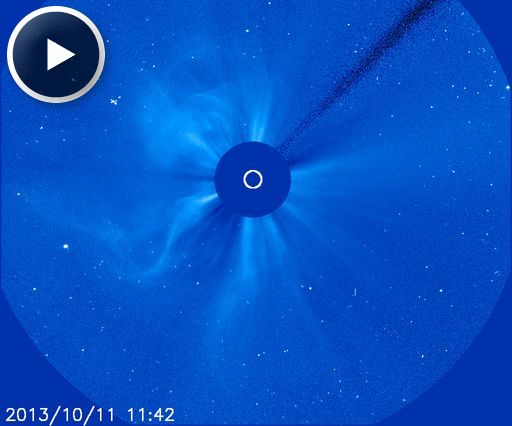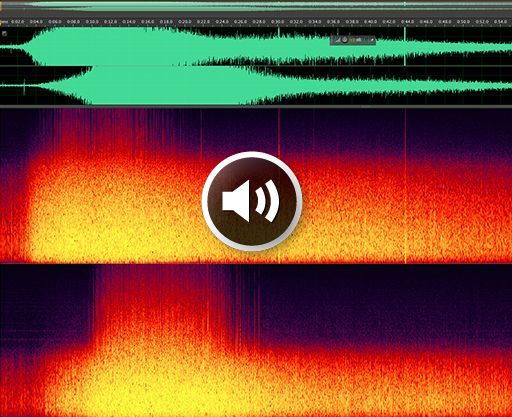JUNO SPACECRAFT PHOTOGRAPHED: On Oct. 9th, NASA's Juno spacecraft buzzed Earth only 347 miles above our planet's surface. It was a slingshot maneuver designed to gain velocity for Juno's long trip to Jupiter (ETA: 2016). Although the spacecraft was very faint, several amateur astronomers managed to photograph it: image gallery. The spacecraft is now hurtling away from Earth at 23,500 mph. Bon voyage, Juno!
FARSIDE ERUPTION: An active region located just behind the sun's northeastern limb erupted this morning, producing an X-ray flash that registered M1.5 on the Richter Scale of Solar Flares -- despite the fact that it was partially eclipsed by the edge of the sun. The true intensity of the flare was much greater, possibly X-class. The explosion also hurled a spectacular CME into space:
Type II radio emissions from the expanding cloud suggest an expansion velocity of at least 510 km/s (1.1 million mph). That's a typical speed for CMEs.
Within a few days, the sunspot responsible for this outburst will rotate around to the Earthside of the sun. At that time, Earth-directed solar activity could increase. August and September were quiet months, but in October the sun seems to be waking up. Stay tuned! Solar flare alerts: text, voice.
Realtime Space Weather Photo Gallery
RADIO-ACTIVE SUN: Radio amateurs, have you heard any strange roaring sounds coming from the loudspeakers of your shortwave radios this week? It might have been the sun. "The Sun has been generating Type III solar radio bursts and they appear to be intensifying," reports amateur radio astronomer Thomas Ashcraft of New Mexico. "The strongest burst so far came at 2155 UTC on October 9th." Here it is as recorded on two radios at 28 MHz and 21 MHz:
Ashcraft recommends listening to the audio using stereo headphones. "Type III bursts drift downward in frequency," he explains. "In stereo you can hear the burst pass through 28 MHz first on one speaker and then flow through 21 MHz on the other sound speaker."
Type III solar radio bursts are produced by electrons accelerated to high energies (1 to 100 keV) by solar flares. As the electrons stream outward from the sun, they excite plasma oscillations and radio waves in the sun's atmosphere. When these radio waves head in the direction of Earth, they make themselves heard in the loudspeakers of shortwave radios around the dayside of the planet.
More radio bursts could be in the offing. NOAA forecasters estimate a 30% chance of M-class flares and a 5% chance of X-class flares during the next 24 hours. Stay tuned! Solar flare alerts: text, voice.

Solar wind
speed: 390.1 km/sec
density: 2.1 protons/cm3
explanation | more data
Updated: Today at 1606 UT
X-ray Solar Flares
6-hr max: C6 1228 UT Oct11
24-hr: M1 0725 UT Oct11
explanation | more data
Updated: Today at: 1600 UT
![]()
Daily Sun: 11 Oct 13
Sunspot AR1865 has a 'beta-gamma-delta' magnetic field that harbors energy for X-class solar flares. Credit: SDO/HMI
![]()
Sunspot number: 138
What is the sunspot number?
Updated 11 Oct 2013
Spotless Days
Current Stretch: 0 days
2013 total: 0 days (0%)
2012 total: 0 days (0%)
2011 total: 2 days (<1%)
2010 total: 51 days (14%)
2009 total: 260 days (71%)
Since 2004: 821 days
Typical Solar Min: 486 days
Update 11 Oct 2013
The Radio Sun
10.7 cm flux: 121 sfu
explanation | more data
Updated 11 Oct 2013
![]()
Current Auroral Oval:
Switch to: Europe, USA, New Zealand, Antarctica
Credit: NOAA/POES
![]()
Planetary K-index
Now: Kp= 2 quiet
24-hr max: Kp= 2 quiet
explanation | more data
Interplanetary Mag. Field
Btotal: 3.6 nT
Bz: 0.6 nT south
explanation | more data
Updated: Today at 1606 UT
![]()
Coronal Holes: 11 Oct 13
Solar wind flowing from this coronal hole should reach Earth on Oct. 12-13. Credit: SDO/AIA.






